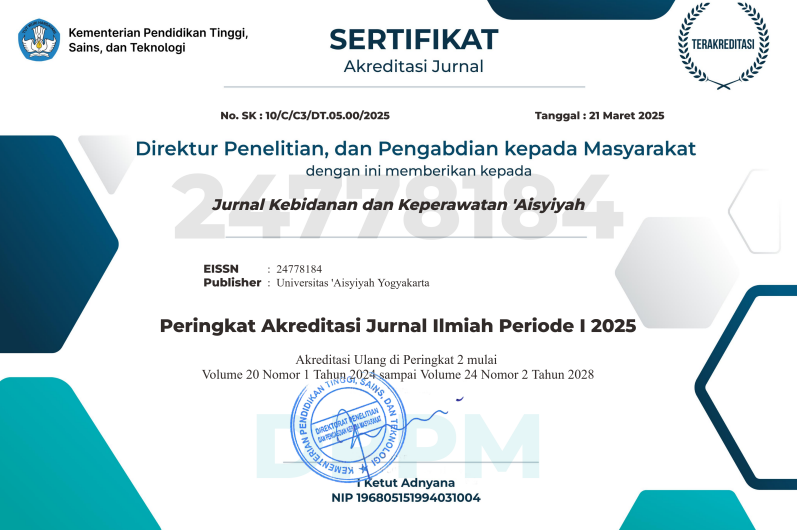Alarm weariness among nurses and its connection to noise sensitivity in critical care units
DOI:
https://doi.org/10.31101/jkk.3973Abstract views 404 times
Keywords:
alarm fatigue, intensive treatment, noise sensitivityAbstract
Downloads
References
Alkubati, S. A., Alsaqri, S. H., Alrubaiee, G. G., Almoliky, M. A., Alqalah, T. A. H., Pasay-An, E., Alrasheeday, A. M., & Elsayed, S. M. (2024). Levels and Factors of Nurses’ Alarm Fatigue in Critical Care Settings in Saudi Arabia: A Multicenter Cross-Sectional Study. Journal of Multidisciplinary Healthcare, 17, 793–803. https://doi.org/10.2147/JMDH.S452933
Asadi, N., Salmani, F., Asgari, N., & Salmani, M. (2022). Alarm fatigue and moral distress in ICU nurses in COVID-19 pandemic. BMC Nursing, 21(1), 1–7. https://doi.org/10.1186/s12912-022-00909-y
Bach, T. A., Berglund, L. M., & Turk, E. (2018). Managing alarm systems for quality and safety in the hospital setting. BMJ Open Quality, 7(3), e000202. https://doi.org/10.1136/bmjoq-2017-000202
Bariana, Y. A., Dewi, A., & Marianna, S. (2024). Noise Tolerance To Patient Comfort in The High Care Unit (HCU). Jurnal Keperawatan Kritis Indonesia, 2(1), 1–6.
Bi, J., Yin, X., Li, H., Gao, R., Zhang, Q., Zhong, T., Zan, T., Guan, B., & Li, Z. (2020). Effects of monitor alarm management training on nurses’ alarm fatigue: A randomised controlled trial. Journal of Clinical Nursing, 29(21–22), 4203–4216. https://doi.org/10.1111/jocn.15452
Bourji, H., Sabbah, H., Al’Jamil, A., Khamis, R., Sabbah, S., Droubi, N., & Sabbah, I. M. (2020). Evaluating the Alarm Fatigue and its Associated Factors among Clinicians in Critical Care Units. European Journal of Clinical Medicine, 1(1), 1–10. https://doi.org/10.24018/clinicmed.2020.1.1.8
Claudio, D., Deb, S., & Diegel, E. (2021). A Framework to Assess Alarm Fatigue Indicators in Critical Care Staff. Critical Care Explorations, 3(6), E0464. https://doi.org/10.1097/CCE.0000000000000464
Giano Tani, S., Vanda Doda, D. D., Kandou, G. D., & Kesehatan Masyarakat Universitas Sam Ratulangi Manado ABSTRAK, F. (2022). Hubungan antara kebisingan dengan tingkat kelelahan kerja pada nelayan ikan KM. Chorintias Tumumpa Manado. Jurnal KESMAS, 11(4), 1–6.
Hravnak, M., Pellathy, T., Chen, L., Dubrawski, A., Wertz, A., Clermont, G., & Pinsky, M. R. (2018). A call to alarms: Current state and future directions in the battle against alarm fatigue. Journal of Electrocardiology, 51(6), S44–S48. https://doi.org/10.1016/j.jelectrocard.2018.07.024
Istanti, E., & Fatwati Fitriana, N. (2024). Hubungan Paparan Kebisingan, Suhu Ruangan Dan Kelembaban Udara Dengan Kualitas Tidur Pasien Di Ruang Intensive Care Unit (Icu) Rsud Banyumas. Nursing Sciences Journal, 8(1), 56–65. https://doi.org/10.30737/nsj.v8i1.5163
Kishikawa, H., Matsui, T., Uchiyama, I., Miyakawa, M., Hiramatsu, K., & Stansfeld, S. (2006). The development of Weinstein’s noise sensitivity scale. Noise Health, 8(33), 154–160. https://doi.org/10.4103/1463-1741.34703
Kooshanfar, Z., Ashrafi, S., Paryad, E., Salmanghasem, Y., Khaleghdoost Mohammadi, T., Kazemnezhad Leili, E., & Mohammad Javad Golhosseini, S. (2022). Sources of noise and their effects on nurses in intensive care units: A cross sectional study. International Journal of Africa Nursing Sciences, 16(October 2021), 100403. https://doi.org/10.1016/j.ijans.2022.100403
Lewandowska, K., Weisbrot, M., Cieloszyk, A., Mędrzycka-Dąbrowska, W., Krupa, S., & Ozga, D. (2020). Impact of alarm fatigue on the work of nurses in an intensive care environment—a systematic review. International Journal of Environmental Research and Public Health, 17(22), 1–14. https://doi.org/10.3390/ijerph17228409
Nguyen, N. T., Douglas, C., & Bonner, A. (2019). Effectiveness of self-management programme in people with chronic kidney disease: A pragmatic randomized controlled trial. Journal of Advanced Nursing, 75(3), 652–664. https://doi.org/10.1111/jan.13924
Nyarko, B. A., Yin, Z., Chai, X., & Yue, L. (2024). Nurses’ alarm fatigue, influencing factors, and its relationship with burnout in the critical care units: A cross-sectional study. Australian Critical Care, 37(2), 273–280. https://doi.org/10.1016/j.aucc.2023.06.010
Pal, J., Taywade, M., Pal, R., & Sethi, D. (2022). Noise Pollution in Intensive Care Unit: A Hidden Enemy affecting the Physical and Mental Health of Patients and Caregivers. Noise and Health, 24(114), 130–136. https://doi.org/10.4103/nah.nah-79-21
Papazian, L., Sylvestre, A., & Herridge, M. (2018). Should all ICU clinicians regularly be tested for burnout? Yes. Intensive Care Medicine, 44(5), 681–683. https://doi.org/10.1007/s00134-018-5094-z
Paredath, M. S., & Al Jarary, K. L. (2023). The effect of applying alarm fatigue strategies related to nursing performance. International Journal of Research in Medical Sciences, 11(4), 1073–1079. https://doi.org/10.18203/2320-6012.ijrms20230846
Regmi, B., Shrestha, B., Khanal, S., Moktan, S., & Byanju, R. (2023). Alarm Fatigue among Nurses Working in Critical Care Setting in a Tertiary Hospital, Nepal. Kathmandu University Medical Journal, 21(1), 28–32.
Saeed, M. S. (2016). The Impact of Job Satisfaction and Knowledge Sharing on Employee Performance. Journal of Resources Development and Management, 21(1992), 16–23.
Salameh, B., Abdallah, J., Alkubati, S. A., & Albashtawy, M. (2024). Alarm fatigue and perceived stress among critical care nurses in the intensive care units: {Palestinian} perspectives. BMC Nursing, 23(1). https://doi.org/10.1186/s12912-024-01897-x
Schlesinger, J. J., Baum Miller, S. H., Nash, K., Bruce, M., Ashmead, D., Shotwell, M. S., Edworthy, J. R., Wallace, M. T., & Weinger, M. B. (2018). Acoustic features of auditory medical alarms—An experimental study of alarm volume. The Journal of the Acoustical Society of America, 143(6), 3688–3697. https://doi.org/10.1121/1.5043396
Schondelmeyer, A. C., Brady, P. W., Goel, V. V., Cvach, M., Blake, N., Mangeot, C., & Bonafide, C. P. (2018). Physiologic monitor alarm rates at 5 children’s hospitals. Journal of Hospital Medicine, 13(6), 396–398. https://doi.org/10.12788/jhm.2918
Shaban Aysha, Z. M., & Sayed Ahmed, S. E. (2019). The Effect of Implementing Clinical Alarm Nursing Intervention Program on Nurses’ Knowledge, Practice and Patient Outcomes at Intensive Care Unit. American Journal of Nursing Research, 7(5), 824–835. https://doi.org/10.12691/ajnr-7-5-16
Storm, J., & Chen, H. C. (2021). The relationships among alarm fatigue, compassion fatigue, burnout and compassion satisfaction in critical care and step-down nurses. Journal of Clinical Nursing, 30(3–4), 443–453. https://doi.org/10.1111/jocn.15555
Witek, S., Schmoor, C., Montigel, F., Grotejohann, B., & Ziegler, S. (2025). Sustainable reduction in sound levels on intensive care units through noise management - an implementation study. BMC Health Services Research, 25(1). https://doi.org/10.1186/s12913-024-12059-9
Downloads
Published
How to Cite
Issue
Section
License
Copyright (c) 2025 Jurnal Kebidanan dan Keperawatan Aisyiyah

This work is licensed under a Creative Commons Attribution-ShareAlike 4.0 International License.
With the receipt of the article by the Jurnal Kebidanan dan Keperawatan Aisyiyah Editorial Board and the decision to be published, then the copyright regarding the article will be diverted to Jurnal Kebidanan dan Keperawatan Aisyiyah. Universitas 'Aisyiyah Yogyakarta as the publisher of Jurnal Kebidanan dan Keperawatan Aisyiyah hold the copyright regarding all the published articles in this journal.
Jurnal Kebidanan dan Keperawatan Aisyiyah is licensed under a Creative Commons Attribution-ShareAlike 4.0 International License.
















